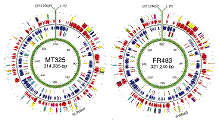Virology, Nebraska Center for
Date of this Version
June 2000
Abstract
Interspecies transmission of the transmissible spongiform encephalopathies (TSEs), or prion diseases, can result in the adaptation and selection of TSE strains with an expanded host range and increased virulence such as in the case of bovine spongiform encephalopathy and variant Creutzfeldt-Jakob disease. To investigate TSE strain adaptation, we serially passaged a biological clone of transmissible mink encephalopathy (TME) into Syrian golden hamsters and examined the selection of distinct strain phenotypes and conformations of the disease-specific isoform of the prion protein (PrPSc). The long-incubation-period drowsy (DY) TME strain was the predominate strain, based on the presence of its strain-specific PrPSc following interspecies passage. Additional serial passages in hamsters resulted in the selection of the hyper (HY) TME PrPSc strain-dependent conformation and its short incubation period phenotype unless the passages were performed with a low-dose inoculum (e.g., 1025 dilution), in which case the DY TME clinical phenotype continued to predominate. For both TME strains, the PrPSc strain pattern preceded stabilization of the TME strain phenotype. These findings demonstrate that interspecies transmission of a single cloned TSE strain resulted in adaptation of at least two strain-associated PrPSc conformations that underwent selection until one type of PrPSc conformation and strain phenotype became predominant. To examine TME strain selection in the absence of host adaptation, hamsters were coinfected with hamster-adapted HY and DY TME. DY TME was able to interfere with the selection of the short-incubation HY TME phenotype. Coinfection could result in the DY TME phenotype and PrPSc conformation on first passage, but on subsequent passages, the disease pattern converted to HY TME. These findings indicate that during TSE strain adaptation, there is selection of a strain-specific PrPSc conformation that can determine the TSE strain phenotype.


Comments
Published in JOURNAL OF VIROLOGY, June 2000, p. 5542–5547 Vol. 74, No. 12. Copyright © 2000, American Society for Microbiology. Used by permission.